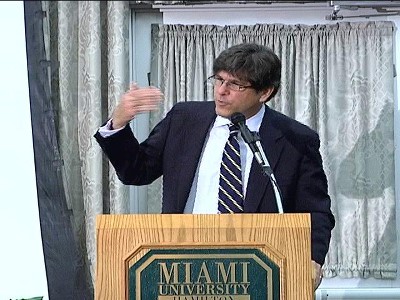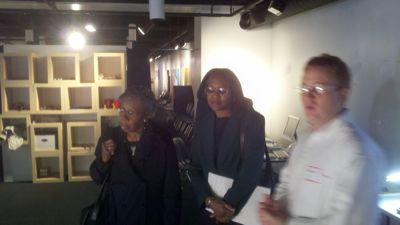I have to admit that I have been eagerly anticipating Sunday night’s premier of AMC’s “Hell on Wheels.” What could be better than the unheralded Anson Mount, one of the best Southern actors of our day, playing an ex-Confederate guerrilla looking for his wife’s killer after the Civil War in Nebraska, in and around the building of the Union Pacific Railroad and its rolling town of “Hell on Wheels”?
Nearly ten years ago, Mount played an FBI undercover operator in ABC’s short-lived Line of Fire. That show was set in Richmond, Virginia, and featured a mix of Southern characters much as Justified has done recently. Mount was simply excellent in Line of Fire, and so were the others (especially Leslie Hope), but the slow pace of the show and perhaps its Southernness did not connect with the audience. The Wire was able to capture for Baltimore much more of that city’s quirky and tough street life than Line of Fire could Richmond’s.
Hell on Wheels has already generated some controversy over what exactly the scene of the building of the Union Pacific might have been like and over the plausibility of the show’s mix of Union and Confederate veterans, freed slaves, Native Americans, immigrants, company executives, and town boosters. The Los Angeles Times reviewed Hell on Wheels and mistakenly referred to Colm Meaney’s character as Thomas “Doc” Duncan–it was Thomas C. “Doc” Durant. The picture of so many freedmen in the scene has prompted questions.
One controversy has erupted over whether Chinese laborers worked on the Union Pacific. The answer is no, at least not according to the Union Pacific records. Jeff Yang’s Wall Street Journal piece, “Do Chinese Pioneers Get Railroaded in AMC’s ‘Hell on Wheels’?”, examines the problem of what one commenter called “Asian invisibility.” I have found no records of Chinese laborers on in the Union Pacific payrolls in the 1865-68 period. The U.S. Census, while not the most reliable in counting some populations, recorded no persons of Chinese birth in Nebraska in 1870, nor any Chinese persons living along the counties of the Union Pacific Railroad. Yet, the U.S. Census counted even small populations of individuals, listing sixteen Chinese in Mississippi, two in Michigan, and seven in Colorado Territory that year. In 1870 the census listed 49,310 Chinese persons in California.
On the other hand, there is evidence of freedmen working on the Union Pacific as early as 1863. The U.S. Secretary of the Interior, John P. Usher, reported that year that 300 “free colored laborers” had moved to Council Bluffs, Iowa, to begin working on the Union Pacific Railroad. His office had been “repeatedly urged to use its influence to cause as many colored laborers as can be procured to be employed on this work.” (see John P. Usher, Report of the Secretary of the Interior, 1863, p. xix, in Annual Report of the Department of the Interior)
AMC’s promotional material includes photos from the premier, and we see the black freedmen prominently in them. It would help if we could gain a renewed sense of the vast displacement and movement that came from the Civil War and its immediate aftermath. Freedmen moved all over and even out of the South. Historian Leslie A. Schwalm has described the movement of freedmen into the Midwest during the war in detail (see Schwalm’s Emancipation’s Diaspora: Race and Reconstruction in the Upper Midwest). It should be no surprise that racial conflict simmered just below the surface and broke into the open at Memphis and other places, including in the North. One white former Confederate’s railroad trip in 1865, and his persistent racially bigoted views, can be found in Stephen Ash, A Year in the South: : 1865: The True Story of Four Ordinary People Who Lived Through the Most Tumultuous Twelve Months in American History (New York, N.Y.: Harper Collins, 2004). Ash traces the story of John Robertson out of Tennessee in 1865 on his way to Chicago and then to Iowa, who finds freedmen in the depots at Nashville and Louisville and stewed that they “had forgot to get out of the way of white people.” Robertson’s annoyance at the changes all around him were further confirmed by his racial prejudices.
Whatever AMC does with this series, the Confederate gunslinging guerrilla played by Anson Mount should prove complicated. Given the recent scholarship on guerrilla warfare in the Civil War–which places the guerrilla action more at the center of the conflict and at the center of the Confederate national commitment–we might expect Mount’s character to carry the resentments and repressed loyalties of his lost cause forward. T. J. Stiles’s biography of Jesse James, for example, indicates how much of the Confederate national project came out of Missouri and continued to burn in the hearts of these men. Mark Geiger’s terrific book on Financial Fraud and Guerrilla Violence in Missouri’s Civil War shows just how the motivations of Confederate guerrillas worked. Whether AMC will deal with the complex motivations and histories of race, white supremacy, and Confederate nationalism remains unclear. We will have to watch to find out!
In the meantime our Railroads and the Making of Modern America project includes some useful documents to put some of the AMC’s Hell on Wheels premier in perspective:
- Incidents of Guerrilla Warfare along the Railroads in the Civil War–Timeline and Map
- Incidents of Black Labor on the Railroads in the Civil War–Timeline and Map
- Photographs of black laborers in 1861-1865
- Payrolls record of the Union Pacific Railroad, 1864-1868
- Letters to and from Thomas C. “Doc” Durant” regarding the Union Pacific Railroad and Credit Mobilier

